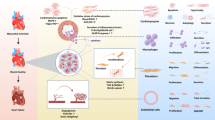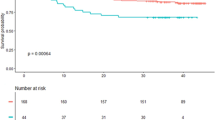Abstract
Cardiac rupture is a fatal complication of acute myocardial infarction lacking treatment. Here, acute myocardial infarction resulted in rupture in wild-type mice and in mice lacking tissue-type plasminogen activator, urokinase receptor, matrix metalloproteinase stromelysin-1 or metalloelastase. Instead, deficiency of urokinase-type plasminogen activator (u-PA–/–) completely protected against rupture, whereas lack of gelatinase-B partially protected against rupture. However, u-PA–/– mice showed impaired scar formation and infarct revascularization, even after treatment with vascular endothelial growth factor, and died of cardiac failure due to depressed contractility, arrhythmias and ischemia. Temporary administration of PA inhibitor-1 or the matrix metalloproteinase-inhibitor TIMP-1 completely protected wild-type mice against rupture but did not abort infarct healing, thus constituting a new approach to prevent cardiac rupture after acute myocardial infarction.
This is a preview of subscription content, access via your institution
Access options
Subscribe to this journal
Receive 12 print issues and online access
$209.00 per year
only $17.42 per issue
Buy this article
- Purchase on Springer Link
- Instant access to full article PDF
Prices may be subject to local taxes which are calculated during checkout





Similar content being viewed by others
References
Reddy, S.G. & Roberts, W.C. Frequency of rupture of the left ventricular free wall or ventricular septum among necropsy cases of fatal acute myocardial infarction since introduction of coronary care units. Am. J. Cardiol. 63, 906–911 (1989).
Varbella, F. et al. Subacute left ventricular free-wall rupture in early course of acute myocardial infarction. Clinical report of two cases and review of the literature. G. Ital. Cardiol. 29, 163 –170 (1999).
Dalrymple-Hay, M.J., Monro, J.L., Livesey, S.A. & Lamb, R.K. Postinfarction ventricular septal rupture: the Wessex experience. Semin. Thorac. Cardiovasc. Surg. 10, 111– 116 (1998).
Zahger, D. et al. Left ventricular free wall rupture as the presenting manifestation of acute myocardial infarction in diabetic patients. Am. J. Cardiol. 78, 681–682 ( 1996).
Peuhkurinen, K., Risteli, L., Jounela, A. & Risteli, J. Changes in interstitial collagen metabolism during acute myocardial infarction treated with streptokinase or tissue plasminogen activator. Am. Heart J. 131, 7–13 (1996).
Knoepfler, P.S., Bloor, C.M. & Carroll, S.M. Urokinase plasminogen activator activity is increased in the myocardium during coronary artery occlusion. J. Mol. Cell Cardiol. 27, 1317–1324 ( 1995).
Rohde, L.E. et al. Matrix metalloproteinase inhibition attenuates early left ventricular enlargement after experimental myocardial infarction in mice. Circulation 99, 3063–3070 (1999).
Robert, V. et al. Differential regulation of matrix metalloproteinases associated with aging and hypertension in the rat heart. Lab Invest. 76, 729–738 (1997).
Tyagi, S.C., Kumar, S., Cassatt, S. & Parker, J.L. Temporal expression of extracellular matrix metalloproteinases and tissue plasminogen activator in the development of collateral vessels in the canine model of coronary occlusion. Can. J. Physiol. Pharmacol. 74, 983– 995 (1996).
Frangogiannis, N.G. et al. Cytokines and the microcirculation in ischemia and reperfusion. J. Mol. Cell Cardiol. 30, 2567– 2576 (1998).
Carmeliet, P. et al. Urokinase-generated plasmin activates matrix metalloproteinases during aneurysm formation. Nature Genet. 17, 439–444 (1997).
Carmeliet, P. et al. Inhibitory role of plasminogen activator inhibitor-1 in arterial wound healing and neointima formation: a gene targeting and gene transfer study in mice. Circulation 96, 3180– 3191 (1997).
George, S.J., Johnson, J.L., Angelini, G.D., Newby, A.C. & Baker, A.H. Adenovirus-mediated gene transfer of the human TIMP-1 gene inhibits smooth muscle cell migration and neointimal formation in human saphenous vein. Hum. Gene Ther. 9, 867–877 (1998).
Alcorn, J.L. et al. Genomic elements involved in transcriptional regulation of the rabbit surfactant protein-A gene. Mol. Endocrinol. 7, 1072–1085 (1993).
Everts, V., van der Zee, E., Creemers, L. & Beertsen, W. Phagocytosis and intracellular digestion of collagen, its role in turnover and remodelling. Histochem. J. 28, 229– 245 (1996).
Nunes, I. et al. Structure and activation of the large latent transforming growth factor-beta complex. Int. J. Obes. Relat. Metab. Disord. 20 Suppl 3, S4–8 ( 1996).
Severs, N.J. Pathophysiology of gap junctions in heart disease. J. Cardiovasc. Electrophysiol. 5, 462–475 (1994).
Carmeliet, P. et al. Role of HIF-1alpha in hypoxia-mediated apoptosis, cell proliferation, and tumor angiogenesis. Nature 394, 485– 490 (1998).
Vandeplassche, G., Hermans, C., Thone, F. & Borgers, M. Stunned myocardium has increased mitochondrial NADH oxidase and ATPase activities. Cardioscience 2, 47–53 ( 1991).
Feldhaus, L.M. & Liedtke, A.J. mRNA expression of glycolytic enzymes and glucose transporter proteins in ischemic myocardium with and without reperfusion. J. Mol. Cell Cardiol. 30, 2475–2485 (1998).
Przyklenk, K., Connelly, C.M., McLaughlin, R.J., Kloner, R.A. & Apstein, C.S. Effect of myocyte necrosis on strength, strain, and stiffness of isolated myocardial strips. Am. Heart J. 114, 1349–1359 (1987).
Schaffer, C.J. & Nanney, L.B. Cell biology of wound healing. Int. Rev. Cytol. 169, 151–181 (1996).
Koyama, H., Raines, E.W., Bornfeldt, K.E., Roberts, J.M. & Ross, R. Fibrillar collagen inhibits arterial smooth muscle proliferation through regulation of Cdk2 inhibitors. Cell 87, 1069–1078 ( 1996).
Plesner, T., Behrendt, N. & Ploug, M. Structure, function and expression on blood and bone marrow cells of the urokinase-type plasminogen activator receptor, uPAR. Stem Cells 15, 398–408 ( 1997).
Kleiner, D.E. & Stetler-Stevenson, W.G. Matrix metalloproteinases and metastasis. Cancer Chemother. Pharmacol. 43, S42–51 (1999).
Chapman, H.A. Plasminogen activators, integrins, and the coordinated regulation of cell adhesion and migration. Cur. Opin. Cell Biol. 9, 714–724 (1997).
Carmeliet, P. et al. Receptor-independent role of urokinase-type plasminogen activator in arterial wound healing and intima formation in mice. J. Cell Biol. 140, 233–245 ( 1998).
Rifkin, D.B., Mazzieri, R., Munger, J.S., Noguera, I. & Sung, J. Proteolytic control of growth factor availability. APMIS 107, 80– 85 (1999).
Borregaard, N. & Cowland, J.B. Granules of the human neutrophilic polymorphonuclear leukocyte. Blood 89, 3503–3521 (1997).
Lee, J.K. et al. A serine elastase inhibitor reduces inflammation and fibrosis and preserves cardiac function after experimentally-induced murine myocarditis. Nature Med. 4, 1383–1391 (1998).
Zhang, B. et al. Functional polymorphism in the regulatory region of gelatinase B gene in relation to severity of coronary atherosclerosis. Circulation 99, 1788–1794 ( 1999).
Lijnen, H.R. & Collen, D. Congenital and acquired deficiencies of components of the fibrinolytic system and their relation to bleeding and thrombosis. Fibrinolysis 3, 67– 77 (1989).
Hamsten, A. et al. Plasminogen activator inhibitor in plasma: risk factor for recurrent myocardial infarction. Lancet 2, 3–9 (1987).
Henry, M. et al. Metabolic determinants are much more important than genetic polymorphisms in determining the PAI-1 activity and antigen plasma concentrations: a family study with part of the Stanislas cohort. Arterioscler. Thromb. Vasc. Biol. 18, 84–91 (1998).
Carmeliet, P. & Collen, D. Vascular development and disorders: molecular analysis and pathogenetic insights. Kidney Int. 53, 1519–1549 (1998).
Carmeliet, P. & Collen, D. Development and disease in proteinase-deficient mice: role of the plasminogen, matrix metalloproteinase, and coagulation system. Thromb. Res. 91, 255–285 (1998).
Lutgens, E. et al. Chronic myocardial infarction in mice: cardiac structural and functional changes. Cardiovasc. Res. 41, 586–593 (1999).
Carmeliet, P. et al. Impaired myocardial angiogenesis and ischemic cardiomyopathy in mice lacking the vascular endothelial growth factor isoforms VEGF164 and VEGF188. Nature Med. 5, 495– 502 (1999).
Linton, M.F., Atkinson, J.B. & Fazio, S. Prevention of atherosclerosis in apolipoprotein E-deficient mice by bone marrow transplantation. Science 267, 1034–1037 (1995).
Acknowledgements
The authors thank J.M. Herbert and F. Bono for measurements of TGFβ-1; I. Van Horebeek for help with ATP and lactate measurements; R. Gerard for the AdRR5 and AdPAI-1 adenovirus, M. Van Bilzen, P. Doevedans and M. Palmen; and A. Bouché, M. De Mol, I. Cornelissen, B. Hermans, K. Deroover, A. Manderveld, S. Jansen, A. Vandenhoeck, P. Van Wesemael, S. Wyns and F. Thoné. S.H. is a Fund for Scientific Research. research assistant; G.T. is a recipient of the German Research Foundation.
Author information
Authors and Affiliations
Corresponding author
Rights and permissions
About this article
Cite this article
Heymans, S., Luttun, A., Nuyens, D. et al. Inhibition of plasminogen activators or matrix metalloproteinases prevents cardiac rupture but impairs therapeutic angiogenesis and causes cardiac failure . Nat Med 5, 1135–1142 (1999). https://doi.org/10.1038/13459
Received:
Accepted:
Issue Date:
DOI: https://doi.org/10.1038/13459
This article is cited by
-
Cardiac Overexpression of Chil1 Improves Wound Healing to Prevent Cardiac Rupture After Myocardial Infarction
Journal of Cardiovascular Translational Research (2023)
-
Matrix metalloproteinases in coronary artery disease and myocardial infarction
Basic Research in Cardiology (2023)
-
Don’t go breakin’ my heart: cardioprotective alterations to the mechanical and structural properties of reperfused myocardium during post-infarction inflammation
Biophysical Reviews (2023)
-
Gene expression of fibrinolytic markers in coronary thrombi
Thrombosis Journal (2022)
-
A combined biomarker approach for characterising extracellular matrix profiles in acute myocardial infarction
Scientific Reports (2021)



